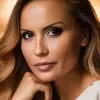What a treat it is for an embroidery enthusiast to see a needle smoothly doing its dance on a piece of fabric, leaving beautiful even stitching behind its path, don’t you agree? Having been used to such perfection of consistency it is really disappointing to one day start to notice flaws (looping, slacking of stitching, uneven edges) in the work or even worse – run into breakage of the needle or damage in the fabric. To always be on point in this matter, it is crucial to know not only your stabilizers, fabrics and threads, but also what type of needle to use on each particular case. To ensure best results for your embroidery projects, the following chapter rounds up all the useful information on how to pick the right needle.
Main features to take into account when deciding upon the needle are: the size of the needle, the size of its eye and the form of the needle point.
The size is always written on the package and on the shank of each needle. Usually it consists of two numbers (e.g. 65/9, 90/14). The first number may vary from 60 to 120 and is a metric (a.k.a. in millimeters) reference to the diameter of the blade of a needle. The second one is its imperial correlate (a.k.a. in inches). They run from 8 to 19. So, a needle with numbers 65/9 has 0, 65 mm. (or 0, 09”) in its blade diameter. Needles with small numbers are used for lighter, thinner fabrics, because otherwise the holes that they leave while stitching may be too big, which causes uneven coverage of the space or even damage of the fabric. As a general reference, one can use size 60/8 to embroider silk, organza and other airy textiles. Sturdier textiles like jeans or canvas could be worked on with needles of 90/14 or 80/12 sizes.
The size of the eye is determined by the type of the tread. Unlike regular threads, metallic and decorative ones require needles with larger eyes. This will lessen the friction of the “capricious” treads and prevent their wear and breakage.
With the needle points the thing is a little bit more interesting. The point is the first part of the needle to puncture the fabric and is distinguished by the way it goes through the textile into 3 types: sharp point, ball point and wedge point. Each type has its own group of fabric, which it can be used on.
Wedge point needles work beautifully for leathers, heavy fabrics and non-woven textiles because the peculiar form of its points cut through the fabric, leaving neat slits and not holes.
Sharp point needles could be used on almost every type of fabric, with exception to some light, airy knits. It punctures the fabric in a different way than wedge point needles, leaving tiny perforations. This needle type runs well through thick, sturdy textiles, without causing any stretching.
Ball point needles are great for all kinds of knits, especially stretchy ones. The shape of the point of these needles is somewhat rounded and softer than the other types. This helps the needle to slide in between the fibers, instead of cutting through them and damaging delicate fabrics. There are light, medium and heavy ball point types. With “crumblier” textiles heavy ball points are used because of their duller, more rounded head. Light and medium ones could be used for embroidery on some woven fabrics as well as knits.
Experienced embroidery artists suggest to take into account all of the abovementioned information to achieve beautiful results in your projects. Besides it is also important to pay attention to the condition of the needle during the work. Practice shows that after some time, needles lose their sharpness, which may cause thread break or other damage. There are many opinions on how often a needle should be changed: depending on the density of the fabrics, that you use most often or hours of continuous work, the number may vary. The general rule is this: even if you don’t see any deterioration in the work, after 2 000 000 stitches you should change the needle, because after that point it may break at most inconvenient moment.
You may also like
Tear away stabilizers for machine embroidery

Author: Ludmila Konovalova
My name is Ludmila Konovalova, and I lead Royal Present Embroidery. Embroidery for me is more than a profession; it is a legacy of my Ukrainian and Bulgarian heritage, where every woman in my family was a virtuoso in cross-stitch and smooth stitching. This art, passed down through generations, is part of my soul and a symbol of national pride.
Date: 01.02.2024





 Get Sign-In Link
Get Sign-In Link Login with Google
Login with Google Login with Facebook
Login with Facebook Login with Amazon
Login with Amazon Login with Paypal
Login with Paypal